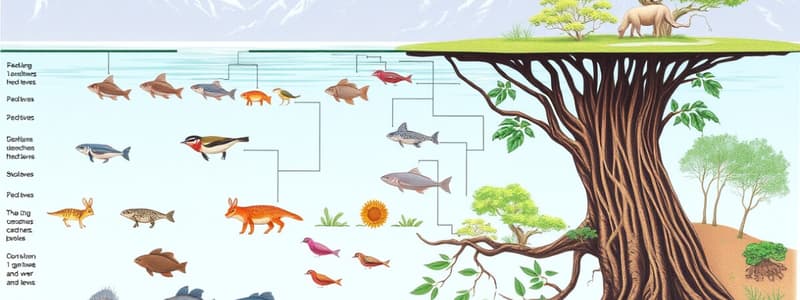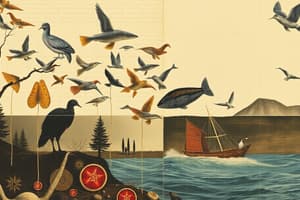Podcast
Questions and Answers
Which term describes organisms that can produce their own food using sunlight or chemical processes?
Which term describes organisms that can produce their own food using sunlight or chemical processes?
- Scavengers
- Heterotrophs
- Producers (correct)
- Consumers
In an energy pyramid, which trophic level contains the most energy?
In an energy pyramid, which trophic level contains the most energy?
- Secondary consumers
- Primary consumers
- Producers (correct)
- Tertiary consumers
What role do decomposers play in an ecosystem?
What role do decomposers play in an ecosystem?
- They compete with herbivores for food.
- They break down organic matter and recycle nutrients. (correct)
- They consume primary consumers.
- They produce energy through photosynthesis.
Which of the following is NOT a characteristic of a food web?
Which of the following is NOT a characteristic of a food web?
Which type of organism feeds on both plants and animals?
Which type of organism feeds on both plants and animals?
What is the primary difference between a food chain and a food web?
What is the primary difference between a food chain and a food web?
In an energy pyramid, which characteristic is common among organisms at higher trophic levels?
In an energy pyramid, which characteristic is common among organisms at higher trophic levels?
Which type of organism acts as a scavenger in an ecosystem?
Which type of organism acts as a scavenger in an ecosystem?
Which of the following describes an omnivore's feeding habits?
Which of the following describes an omnivore's feeding habits?
What distinguishes autotrophs from heterotrophs in terms of energy acquisition?
What distinguishes autotrophs from heterotrophs in terms of energy acquisition?
Flashcards are hidden until you start studying
Study Notes
Food Chain and Food Web
- A food chain outlines a linear sequence of organisms, illustrating who eats whom within an ecosystem.
- A food web is a complex model that demonstrates how many food chains interconnect and interact within an ecosystem.
Trophic Levels
- Trophic levels categorize organisms based on their position in the food chain: producers, primary consumers, secondary consumers, and tertiary consumers.
- Each level represents a step in the transfer of energy and nutrients, with energy decreases as one moves up the pyramid.
Producers and Autotrophs
- Producers, or autotrophs, are organisms that create their own food, typically through photosynthesis or chemosynthesis.
- Photosynthesis captures sunlight to convert carbon dioxide and water into glucose and oxygen, primarily performed by plants and certain algae.
Consumers and Heterotrophs
- Consumers, or heterotrophs, are organisms that rely on consuming other organisms for energy.
- Various types of consumers include:
- Herbivores (plant eaters)
- Carnivores (meat eaters)
- Omnivores (both plant and animal eaters)
Decomposers and Scavengers
- Decomposers break down dead organic matter, returning essential nutrients to the soil; examples include fungi and bacteria.
- Scavengers consume dead animals and play an important role in the ecosystem by facilitating decomposition.
Energy Pyramid
- The energy pyramid illustrates the distribution of energy across trophic levels, showing that only a small percentage of energy (about 10%) is transferred from one level to the next.
- Energy loss occurs primarily through metabolic processes and heat.
Chemosynthesis
- Chemosynthesis refers to the process by which certain organisms, such as bacteria, convert inorganic compounds into organic matter using chemical energy, often found in deep-sea environments.
Studying That Suits You
Use AI to generate personalized quizzes and flashcards to suit your learning preferences.




